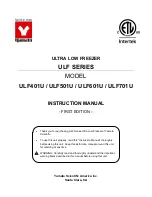
O-UC12-FEB23-3
Page 3
Expansion Valve
•
Expansion valve is not pre-fitted into all unit models.
•
External pressure equalization type thermostatic
expansion valve needs to be used with this type of unit
cooler to compensate pressure drop through the
evaporator and distributors.
•
For one outdoor to one indoor system low temperature
application, a maximum operating pressure (MOP) type
expansion valve must be used to limit the suction
pressure rise to a maximum of 4 bar relative (-5
0
C).
Higher suction pressure than compressor working
envelope might cause compressor overload. Do not
apply both suction pressure regulator and MOP-type
expansion valve in combination with one another.
•
When required, access to the adjusting screw of
expansion valve to alter the suction superheat. To avoid
liquid back to compressor, it is recommended suction
superheat 10K to 20 K for normal operating condition.
Electrical
•
The mains electrical supply to the indoor unit must be
via a suitably rated isolator and motor rated circuit
breaker or fuse.
•
Check electrical safety (leakage current, withstand
voltage, earth continuity) after connected to heaters,
fuse, and timers.
•
Thermal fuse must be supplied by site to protect the
defrost heater from overheating.
Daikin Slim Unit Cooler require a
230 volt / 1 phase / 50Hz
supply which must include Earthing. They are not suitable for
any other supply voltages (other than a deviation of +/- 10%
of the above values) and are not suitable for 60 Hz supplies.
Units must be earthed, and no maintenance work should be
attempted prior to disconnecting the electrical supply.
Installation of earth wire should be made to earth screw
before connecting the live wires. The earth wire shall be
slacked with longer length as shown in below diagram.
•
Cable type and sizing must be selected for the
application and the electrical installation should conform
to the current local standards. The power cable to the
indoor unit should be 3 core (2 core + E).
•
Cables to the indoor unit should be routed through the
bush wires of the electrical metal enclosure.
•
Removal of the metal cover plate gives access to the
terminal blocks for the fan and heater. The wiring
diagram could be found at the inner side of the metal
cover plate.
•
A defrost heater is pre-inserted at the bottom of the coil.
To protect the heater from overheating, it is important to
install a thermal fuse (to be supplied by site) in the
heater circuit. The thermal fuse should be appropriately
located to cut off safely when the heater is overheated.
Commissioning
Before starting the system, ensure that all
electrical connections are correctly made and
tight, and all covers and guards are fitted.
After the installation is completed, a review of the
following items should be performed before the
system is placed into operation:
Check electrical connections, fan motors, fan guard and
all other fasteners for tightness. Ensure the thermostatic
expansion valve bulb is properly located, strapped,
and insulated.
With the system operating, check the supply voltage. It
must be /- 10% of the voltage marked on the unit
nameplate.
Be alert that during defrosting, the surrounding
temperature of the unit may rise dramatically.
Kindly keep a safe distance from the unit.
A defrost cycle is needed when the frost build up is such
that it impedes the airflow through the coil. The defrost
settings is vary for each installation and may need to be
changed depending on the time of the year and other
conditions.
Check the drain line and make sure drain line is clear and
unit is aligned in all position to avoid overflow of
condensation water.
Heater
Location






























